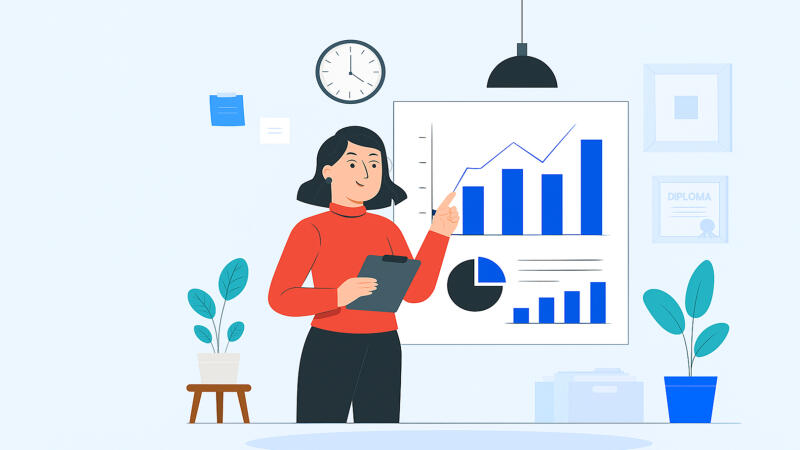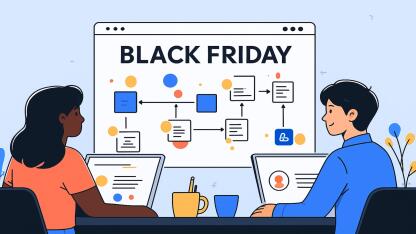When it comes to SEO today, high-quality backlinks are among the most valuable assets you can earn. Unlinked brand mentions open up new opportunities for developing advanced and effective link-building strategies.
An unlinked mention occurs when a brand, company, or product is referenced in online sources, such as articles, interviews, news reports, or reviews, without an active hyperlink to the official website.
At first glance, this kind of reference might appear to be just a simple gesture aimed at enhancing brand reputation. However, it's essentially a link that has already been earned; it just needs to be finalized to achieve its full potential and desired results. When approached correctly, it can be converted into a full-fledged backlink that boosts authority, visibility, and traffic.
In 2025, this approach takes on even greater importance.
First, link-building services are becoming increasingly expensive. High-quality backlinks from reputable domains now take up a significant portion of digital marketing budgets, which, in most cases, are limited.
Second, SEO is becoming increasingly integrated with digital PR, and unlinked mentions serve as a direct bridge between enhanced content visibility and improved search engine rankings.
Third, in a market oversaturated with links, naturalness, and relevance are more critical than ever. That's why working with existing mentions allows marketers to build a strong and organic backlink profile.
Search engine ranking is becoming increasingly competitive, and traditional link-building methods are becoming more expensive. It makes the strategic use of unlinked brand mentions one of the most efficient ways to improve your website's rankings while simultaneously promoting the products or services you offer.
In this article, we'll take a closer look at what unlinked mentions are in the context of SEO, how to find and analyze them, and, most importantly, how to successfully convert them into high-quality, effective backlinks.
What Are Unlinked Brand Mentions?
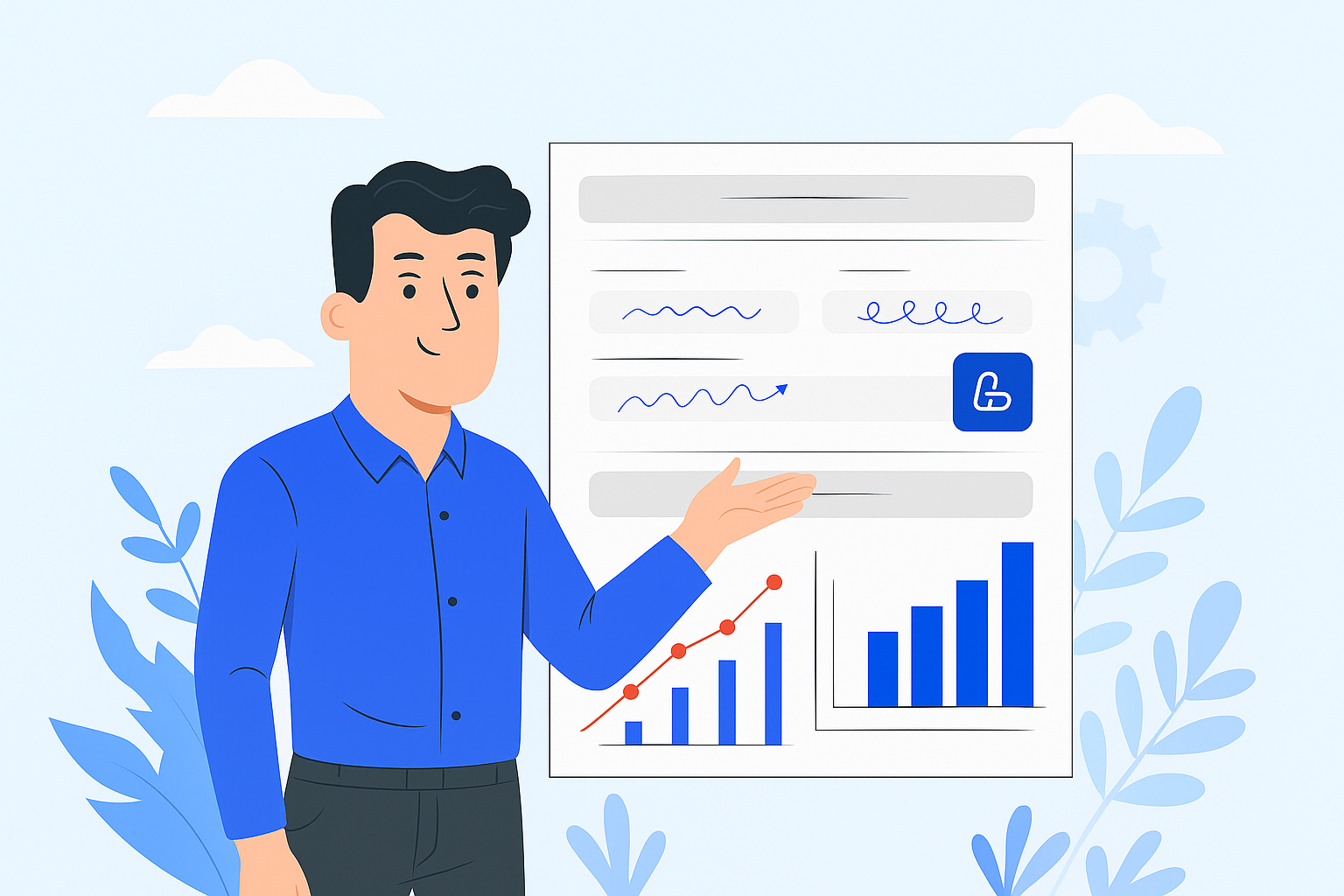
As we've established, unlinked brand mentions refer to situations where a name of a company, product, or personal brand is mentioned in publicly accessible online content without a hyperlink to its official website. These mentions may appear in various types of content, including news articles, blogs, reviews, interviews, analytical reports, or list-based articles.
Technically, they are not full-fledged backlinks, as they don't include a direct URL pointing to the source. However, such mentions still effectively highlight the brand's presence and position in the market.
An unlinked mention is a textual element that identifies a brand or product but does not provide a clickable path to the website. It could be part of a paragraph, headline, image caption, or even a comment. While search engines may treat these mentions as soft signals or indicators, they do not carry link equity for ranking purposes. That's why, within SEO campaigns, it's crucial to identify, categorize, and capitalize on these mentions as potential sources of high-quality backlinks.
Examples of Platforms Where Unlinked Mentions Occur
Online Media
Media outlets such as Forbes, Business Insider, or The Guardian frequently publish content that includes statistical or analytical insights, expert commentary, or company rankings. A brand name may be included in the text but without a live hyperlink. These mentions are considered authoritative because they appear on high-trust domains and hold strong potential to be converted into quality backlinks.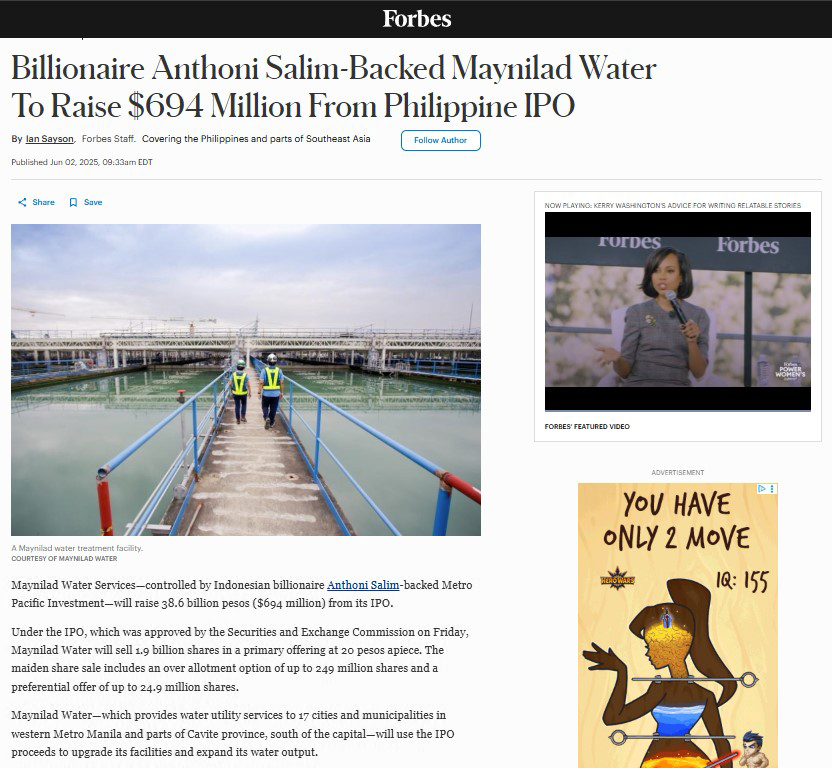
Forums and Communities
On platforms such as Quorra, Reddit, and other communities for professionals, brands are frequently referenced in replies and ongoing discussions. Users may mention the brand name either in full or in abbreviated form, often without including a link. These types of mentions are more challenging to track but can indicate a significant level of trust within the community.
Blogs and Niche Publications
In personal blogs, articles on Medium, Telegra.ph, Substack, or niche media, authors often share their experiences with various services, products, or companies. If a mention lacks a hyperlink, it presents a potential opportunity to contact the author and request that they add a link.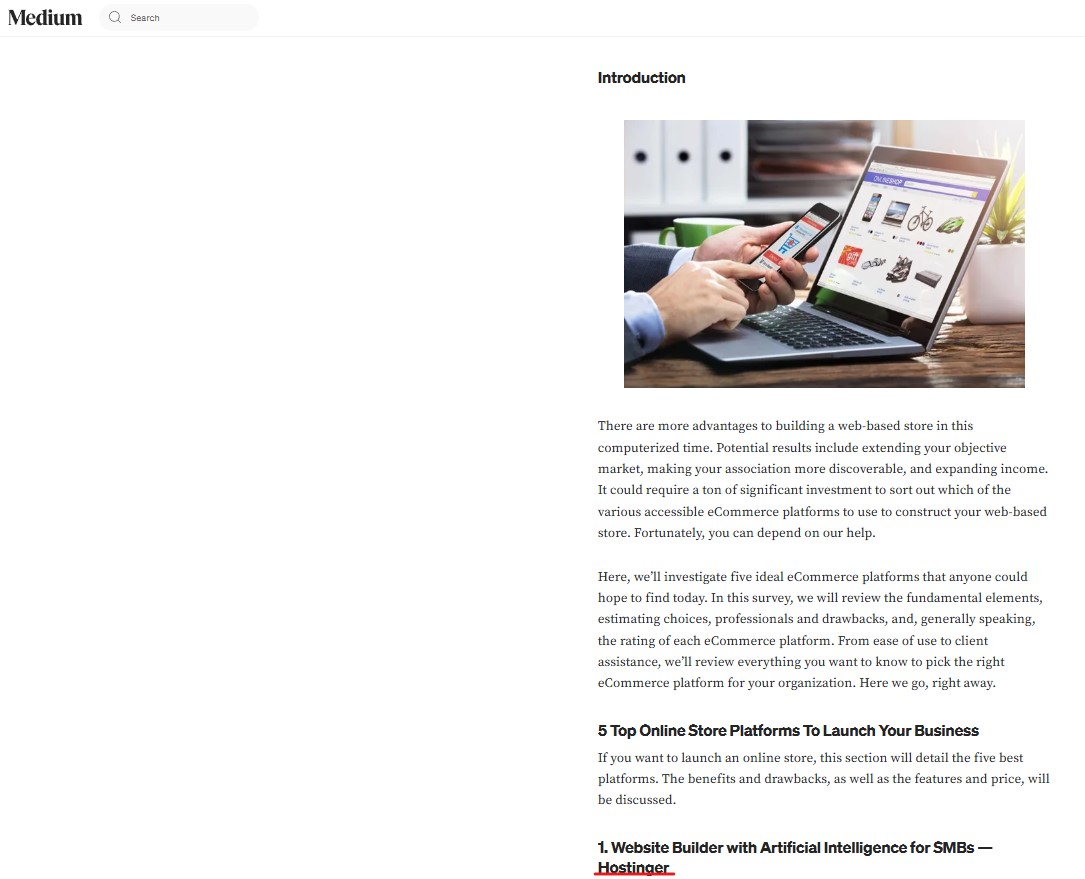
Social Media
On platforms like Facebook, LinkedIn, Twitter/X, and Instagram, users can promote or reference a brand through text, hashtags, or tags, even without including a direct website link. While social media algorithms may not always treat these mentions as traditional backlinks, they still play a crucial role in enhancing brand visibility and influence across the digital landscape.
Videos and Podcasts
In YouTube videos, Reels, TikToks, or audio podcasts, a brand mention may be either spoken or displayed on a screen, but it might not be linked in the description. If there's a caption or a resource section, it's an excellent opportunity to reach out and request that a link be added for the audience's benefit.
Unlinked Mentions vs. Nofollow Links
In the SEO world, unlinked brand mentions are often confused with nofollow links, although they are fundamentally different in both technical implementation and their impact on SEO.
An unlinked mention is plain text that names a brand or domain without an active hyperlink.
For example: "LinkbuildingTools has launched a new feature in its platform."
There's no <a> HTML tag – just text visible to users but minimally valuable to search bots.
A nofollow link is a hyperlink that includes the rel="nofollow" attribute. For example:
<a href="https://linkbuilder.com" rel="nofollow">LinkBuilder</a>
This attribute tells search engines not to pass link equity through this link. In other words, Google or another search engine may recognize the link but will not treat it as a trusted endorsement.
The key difference: a nofollow link is still a link; it can be seen, indexed, and occasionally considered in contexts like E-E-A-T, brand reputation, or general mentions on reputable sources. An unlinked brand mention is simply text that isn't connected to any URL. As such, it doesn't directly provide SEO signals; instead, it offers indirect signals through associations, source authority, and contextual clues.
Additionally, nofollow attributes are editable if you control the content. In contrast, unlinked mentions must be identified and manually handled, ideally turning them into dofollow links when possible.
Why Do Unlinked Mentions Matter?
Although unlinked brand mentions don't carry the direct SEO value of traditional backlinks, their significance in modern digital marketing and SEO strategies is rapidly increasing. Here's why they deserve your attention:
Mentions = Trust Signals
Even without a hyperlink, the appearance of your brand name on an external resource is an indication that people are talking about you. For Google, this serves as a trust signal, especially when the mention appears on a reputable site.
Opportunity to Earn High-Quality Backlinks
An unlinked brand mention is essentially a warm opportunity for link building. If a site has already referenced your brand, there's a good chance they'll be open to adding a link to your site. This approach enables you to grow your backlink profile in a more organic and low-friction manner without resorting to cold outreach to unrelated domains.
Increased Brand Awareness
Mentions on authoritative platforms boost brand recognition, enhance reputation, and build trust with new audiences. Even without a clickable link, a user may remember your name, increasing the chances of direct website visits or follow-up searches.
Improved CTR After Link Insertion
Converting a mention into a hyperlink significantly increases the likelihood of clicks. This, in turn, improves your click-through rate (CTR), user engagement, website traffic, and the perceived value of the page in eyes of search engines.
Google Can Detect Mentions, but Links Remain the Backbone of SEO
Search algorithms are increasingly capable of analyzing the context around a brand mention, not just the link itself. Still, a full hyperlink remains a key ranking factor for top positions. Detecting unlinked mentions provides an opportunity to convert a passive opportunity into a tangible SEO gain.
Advantages and Disadvantages of Unlinked Mentions

Unlinked mentions are not merely passive signals in the informational space. They are a powerful tool for building a strong backlink profile and enhancing brand authority. However, like any strategy, this approach comes with both strengths and weaknesses. It's essential to develop a clear understanding of what to expect and what challenges to anticipate.
Advantages:
- A Free Foundation for Actions
You're working with existing materials, such as articles, interviews, mentions on social media, or blog posts. There's no need to create new content or pay for placement since the mention already exists. All that's left to do is turn it into an active link. - Minimal SEO Risks
Since you're dealing with mentions in already published content, these pages are typically indexed by search engine algorithms. This allows you to assess the quality of the referring domain in advance, significantly reducing the risk of acquiring a spammy backlink, which often occurs with paid links. - Relatively Easy Implementation
If an author or editor has already referenced your brand, they likely hold a positive view of it. In these situations, adding a hyperlink is an easy step that many site owners are willing to take, especially when the request is made politely and professionally. This significantly enhances your chances of successful collaboration. - Establishing Long-Term Relationships
Following up on unlinked mentions is often the first step toward future collaboration, whether that involves securing a backlink, initiating a long-term partnership, or opening the door to other valuable opportunities. It's about building genuine relationships, not just chasing links.
Disadvantages:
- Irrelevant Mentions
Not all mentions carry the same weight in terms of SEO value. Mentions may appear in content that's unrelated to your niche or on websites with low domain authority. Adding a link might be ineffective or even pointless. - Difficult to Measure Impact
It's challenging to track the direct impact of an unlinked mention on your SEO performance or brand awareness. Without an active hyperlink, it's nearly impossible to measure referral traffic, click-through rate (CTR), or lead generation tied to that specific mention. - High Competition
Editors, web admins, and site owners often receive dozens or even hundreds of outreach requests daily. In such a saturated market, you need to invest extra effort into crafting an effective outreach strategy to ensure your request doesn't go unnoticed. - A Process That Requires Patience
Identifying mentions, verifying their quality, gathering contact details, writing personalized emails, sending requests, and waiting for replies is a time-consuming process. It rarely delivers immediate results. Be prepared to play the long game to achieve sustainable and effective outcomes.
Types of Unlinked Mentions

Unlinked mentions are not limited to direct inclusions of a company's name in text or pre-written scripts. They cover a much broader range of content that, in one way or another, hints at or directly relates to your brand. Understanding this helps build a strategic plan for reputation management, identifying potential link sources, and maximizing the use of digital marketing as a driver for quality SEO growth.
Understanding the main categories of mentions and how to work with them effectively is crucial to maximizing the effectiveness of this tactic.
- Direct Brand Mentions
This is the most common format, where the company name appears in the text but without an active hyperlink. Such mentions typically occur in articles, news, brand roundups, or reviews. They have the highest potential for generating leads and converting plain mentions into high-quality backlinks.Example: "In a study conducted by [Brand Name], it was found that…"
- Mentions of Specific Products or Services
Even if the brand name is not mentioned, the content may describe a specific product, service, or characteristic that is easily identifiable with a particular company. Monitoring these mentions is crucial, as they also serve as key touchpoints with the brand.Example: "This tool allows automating link building in just a few clicks." – while the functionality is mentioned, but the brand itself isn’t named.
- Mentions of Company Representatives
Media outlets or private bloggers often quote CEOs, marketing directors, or other public company representatives. Such mentions enhance the personal brand image and simultaneously help build associations connected to the organization. This is an excellent opportunity to add a link to the brand's website as a source or for context.Example: "According to Johnny Johvanni, the Head of Product Development…"
- Mentions of Brand Ambassadors or Partners
If the company has public ambassadors, key opinion leaders, or collaborates with well-known partners, mentions of these individuals can indirectly strengthen brand recognition. This is especially relevant in digital marketing. A pertinent link in such cases can play a crucial role, provided it is valuable and logically integrated into the context.Example: "This expert collaborates with leading brands, including…"
- Mentions of Slogans or Corporate Identity
Sometimes, a brand is identified through a unique slogan, mission, or even a signature visual style. If your motto is mentioned in a review or roundup, it also counts as a form of unlinked mention, which can be a great opportunity to convert it into a quality backlink.Example: "The slogan 'Trust the Process' gained wide popularity in 2024."
- Visual Mentions (Logos, Screenshots, Interface)
The presence of a logo, website screenshot, or use of your content's visual style in presentations, analytical reviews, or videos is a common form of unlinked mention. Since such mentions often lack active links, they need to be tracked via reverse image search or video monitoring tools. Properly leveraging these mentions can secure valuable natural backlinks and reinforce the brand's presence in visual environments.Example: "The slide at the WebMarketing-2025 conference presentation used Company A's logo without credit."
- Mentions on Social Media and Forums
User posts, forum discussions, and social media comments often mention brands without direct hyperlinks. These mentions help build trust in the brand among communities and audiences, but they require proper follow-up to convert into backlinks. Platforms like X (Twitter), Facebook, LinkedIn, Reddit, as well as niche forums, are important sources of such unlinked mentions.Example: "Someone in a Reddit thread recommended CoolService as the best alternative but didn't leave a link to the site."
- Thematic Rankings and Roundups
Brands are often mentioned in articles such as "Top 10 Services for Small Businesses" or "Recommended Tools for Marketers." If the mention lacks a link, it's a prime opportunity to reach out to the author or editorial team to request that a hyperlink be added. These mentions are especially valuable because they typically appear on reputable websites and contribute to the growth of authority.Example: "In the 'Best CRM Systems of 2025' roundup, [Brand Name] was mentioned among market leaders but without a hyperlink to the official site."
In summary, unlinked mentions encompass a much broader spectrum than simply having a company name mentioned somewhere. Understanding this helps to develop strategic reputation management, identify potential link sources, and fully leverage digital PR as a source of quality SEO growth.
How to Find Unlinked Brand Mentions?
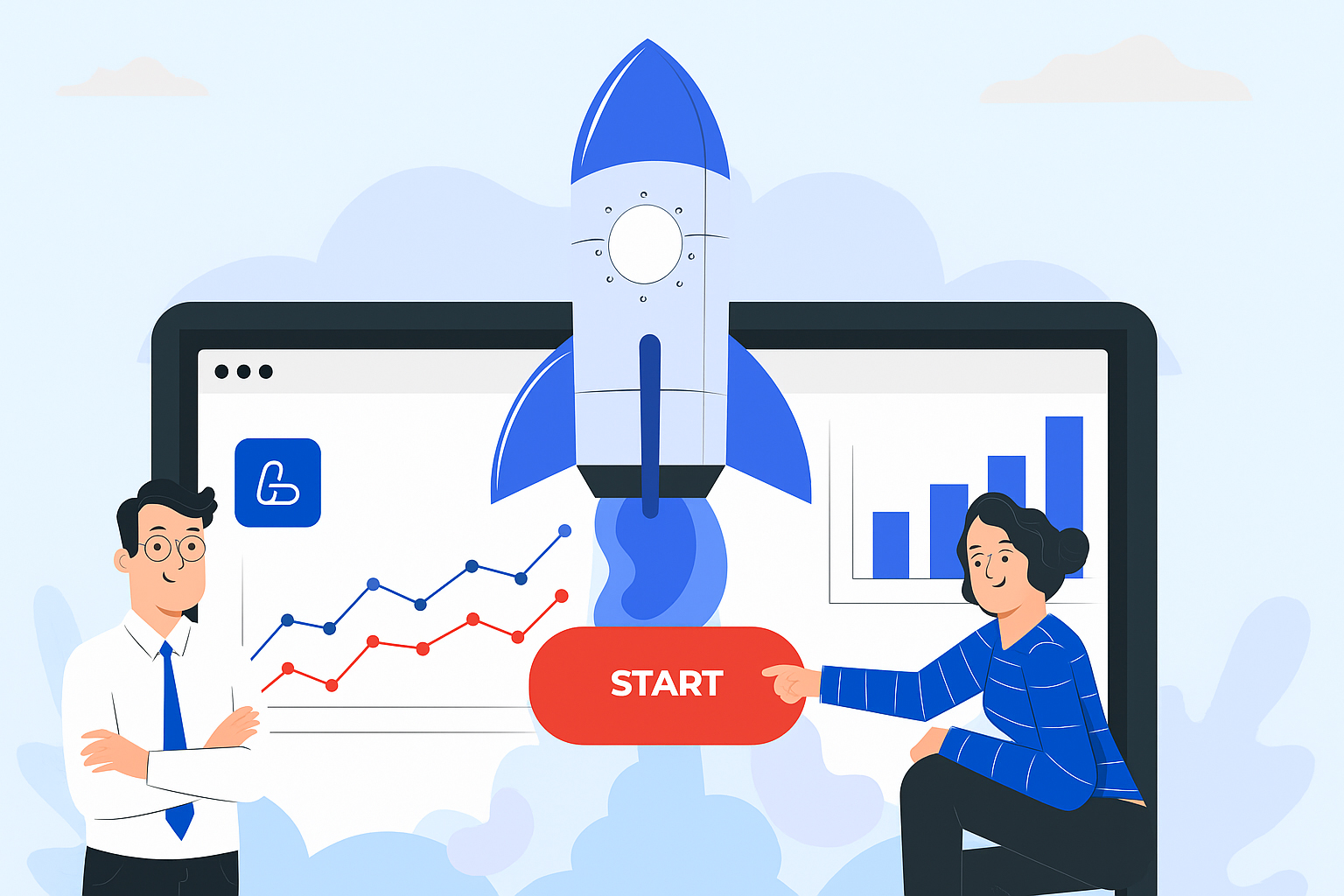
To develop an effective SEO strategy that improves your search rankings and strengthens your market position, it's essential to know how to find unlinked brand mentions across various sources. Such mentions are not always obvious, so it's best to combine automated monitoring tools, manual searches, and in-depth analysis.
Below, we outline key approaches and tools that will help you identify unlinked mentions and turn them into opportunities to strengthen your backlink profile.
Smart Tools for Detecting Brand Mentions
Modern mention monitoring tools make it much easier to track new online mentions of your brand, products, or key figures, and they automate much of the process. With these platforms, you can quickly respond to important mentions, turn them into valuable backlinks, and strengthen your brand's online presence.
On our market, platforms that support monitoring both local and international sources, offer flexible search filters, and provide in-depth analytics are particularly popular. Utilizing these solutions enables brands to stay engaged in the fast-paced digital conversation, adapt their messaging and positioning, and ultimately enhance their SEO performance.
Mention – a solid monitoring tool that analyzes media, blogs, forums, and social networks. It features an intuitive platform interface and notification alerts for new mentions, supporting English and several other popular languages. Mention allows customization for monitoring your brand, competitors, or key topics, making it versatile for various tasks.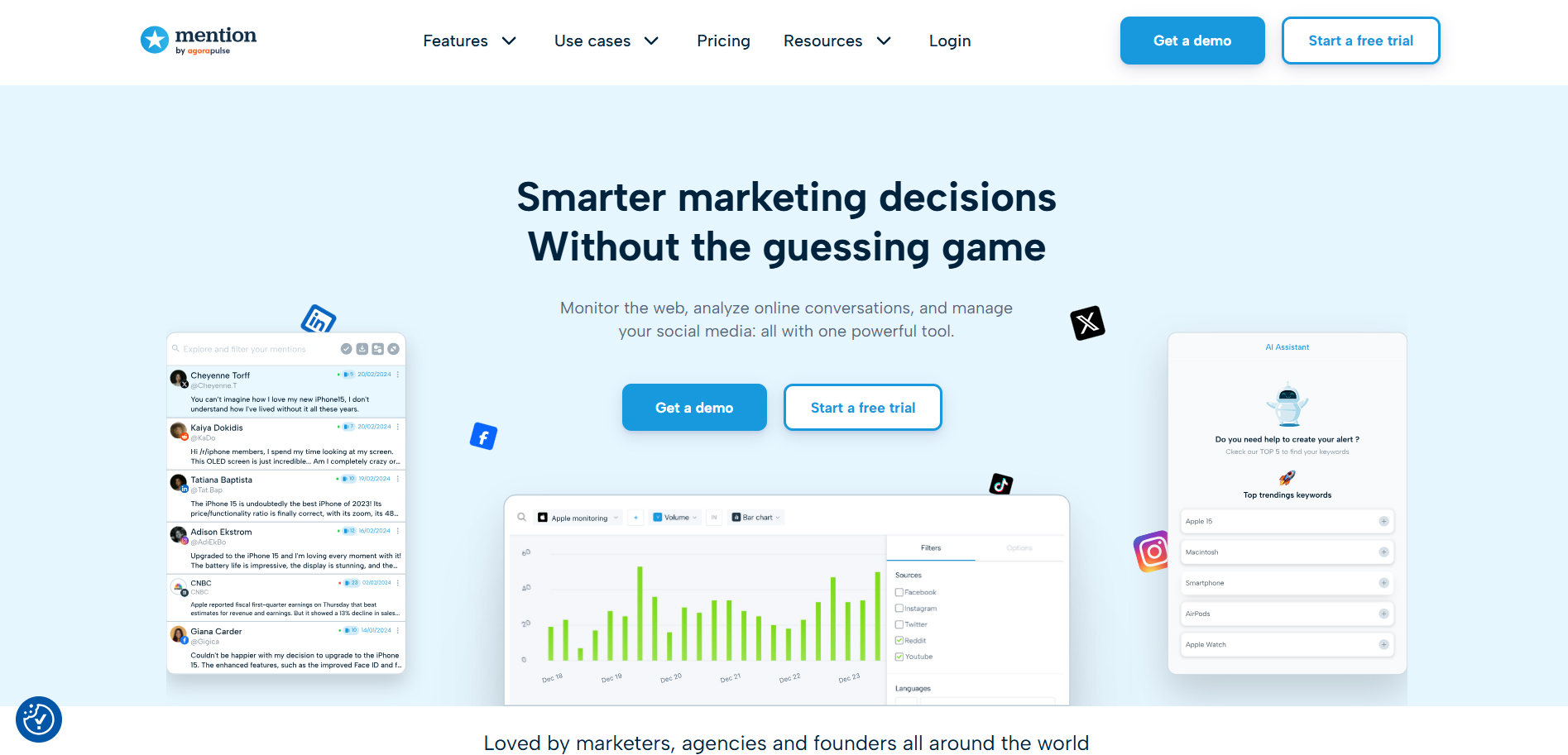
Ahrefs Alerts – has a function that sends notifications about new keyword mentions on any external sites. Using Ahrefs to find unlinked mentions can greatly assist your process, as users can instantly view important SEO metrics (domain rating, organic traffic, total backlinks), which helps them quickly assess the potential value of a mention.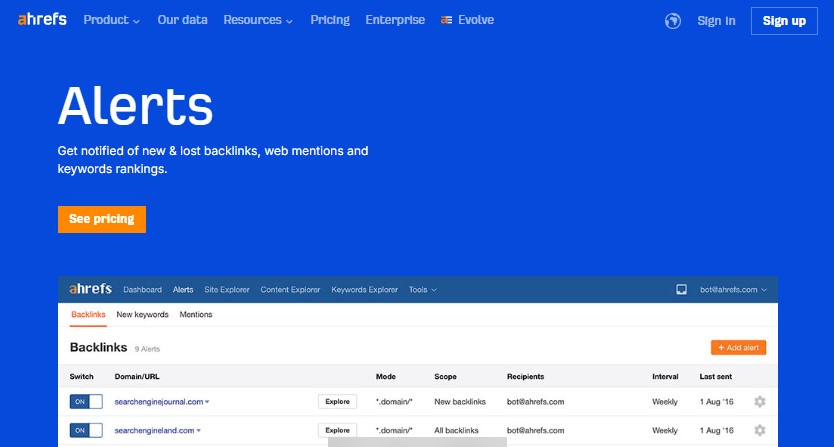
BuzzSumo – a platform for analyzing popular online content and detecting media mentions. BuzzSumo is especially helpful for digital marketers, as it enables the identification of authoritative sources and influential figures, effectively supporting the development of content marketing strategies.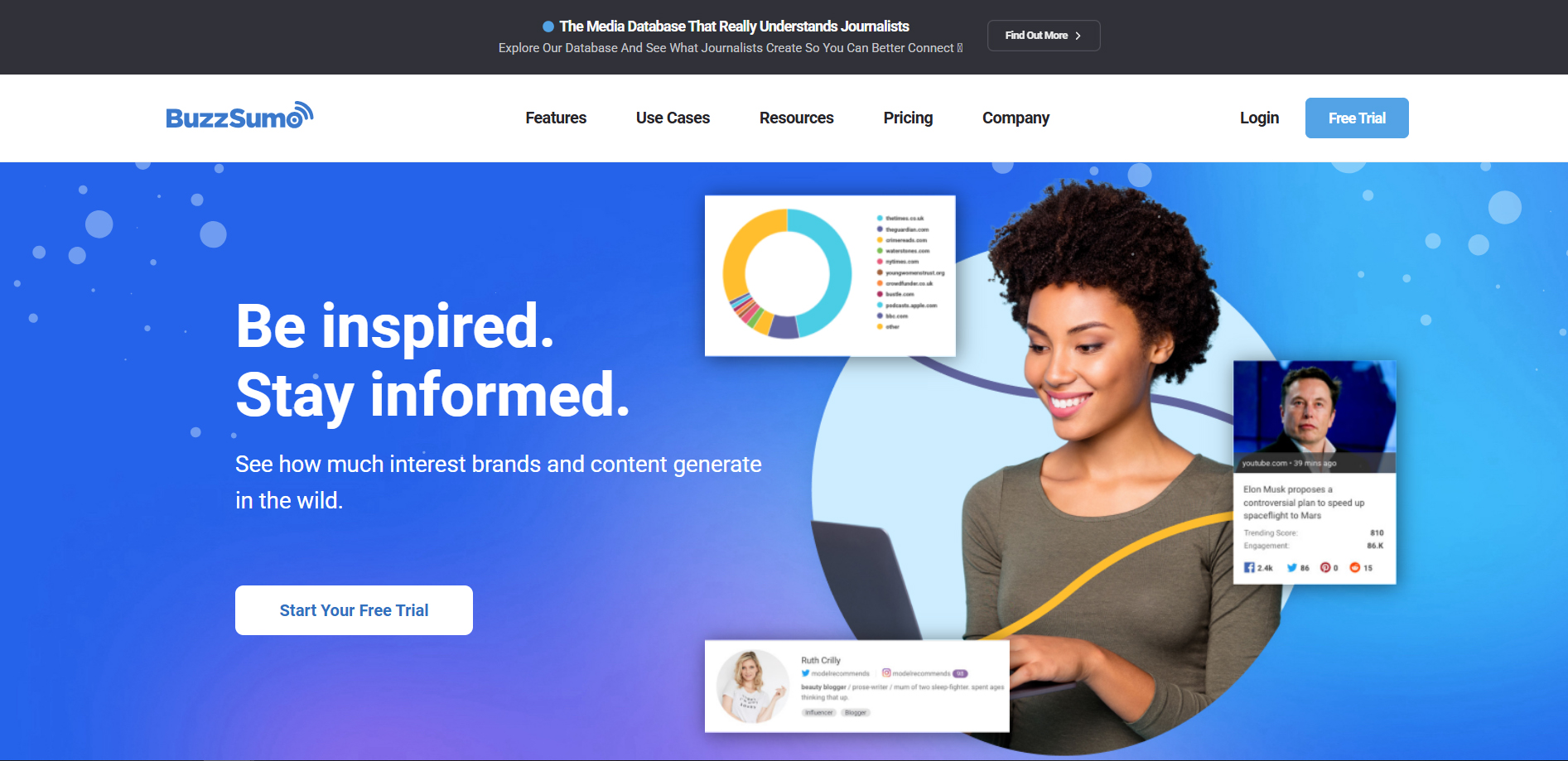
Semrush Brand Monitoring Tool – a tool for convenient tracking of brand mentions across different projects. The service allows filtering results by source types, analyzing quantity and quality of mentions, and tracking changes over time. This is valuable for a deeper understanding of brand reputation and timely strategic improvements.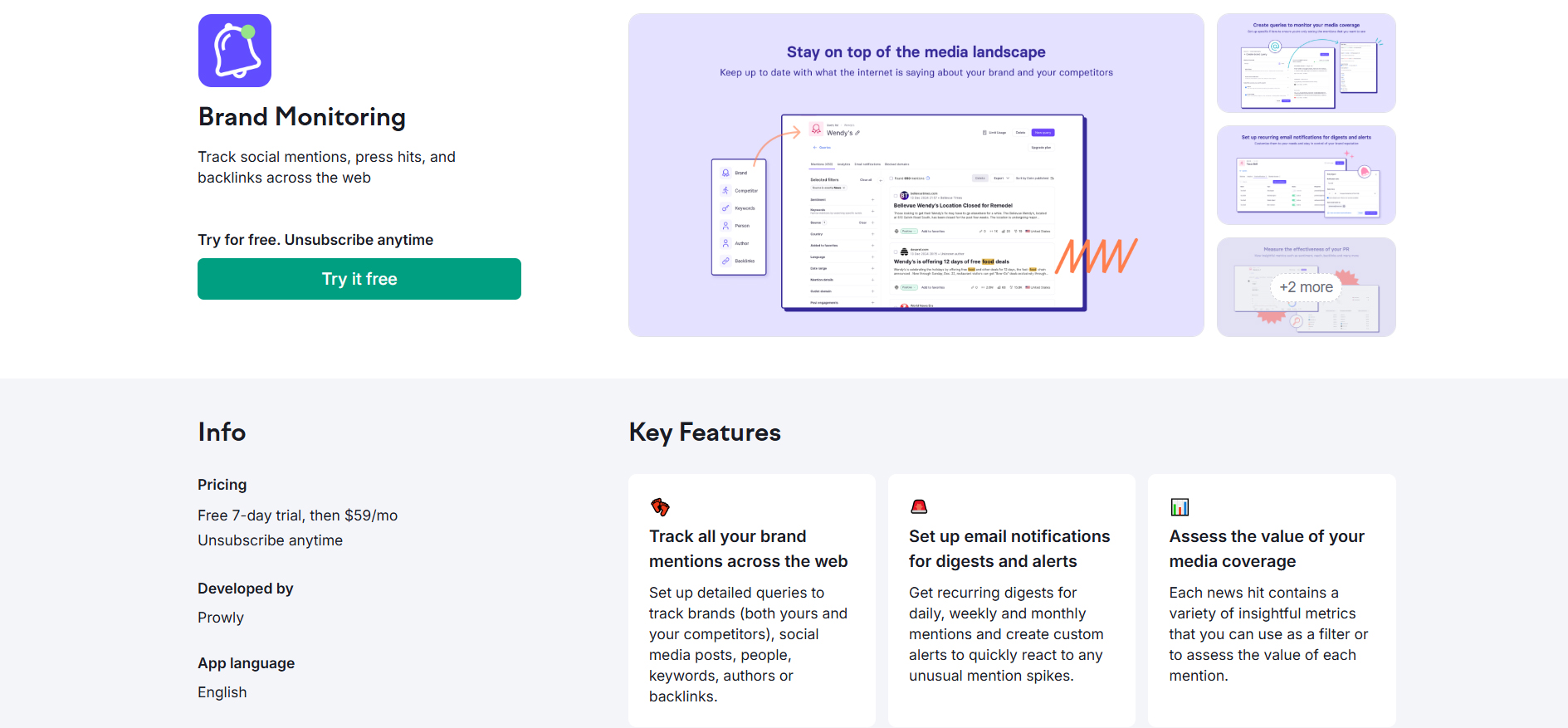
What Exactly to Monitor:
- Brand name and its variations (e.g., BrandName, Brand Name, B-Brand);
- URLs without active links (e.g., brand.com without https://);
- Alternative names, abbreviations, product names, slogans.
Google Alerts + Search Operators
To find unlinked brand mentions manually or for free, combine Google Alerts with advanced Google search operators.
Google Alerts is a simple yet effective tool that sends email notifications when new pages with your specified keywords appear in Google's index. However, keep in mind that Google Alerts doesn't always capture every mention and sometimes misses news or social media posts.
To improve accuracy, use advanced search operators (e.g., "site:," "intext:," "in the title:") to find mentions that meet your criteria manually.
Examples of search operators:
- "BrandName" -site:brand.com
- "BrandName" -inurl:brand.com
- "Brand Name" + review -site:brand.com
- "product name" -site:brand.com
- "BrandName" filetype:pdf
These queries exclude your own site from results and help find mentions on external sources.
Reverse Image Search
Many brand mentions appear as logo usage, interface screenshots, or branded elements without textual mentions or active hyperlinks. To catch these critical signals, use reverse image search tools. They help identify sources using your visual content, even if editors altered its appearance.
Google Images (Search by Image) – upload your brand logo or insert its URL to find all resources using your image.
TinEye – a specialized image search engine that detects even edited or modified versions.
Bing Visual Search – an alternative to Google Images for more precise visual content searches.
Using this toolset, you can easily find all unlinked brand mentions across the web. Once identified, check whether the mention includes a clickable link to your site or any related page. If not, you can reach out to the site owner with a friendly request to add a backlink. It's a simple step that can significantly improve your SEO performance.
Social Media and Niche Communities
Social media is one of the strongest sources of natural brand mentions, often without active links. For effective monitoring, use these platforms:
X (Twitter) – search by keywords, brand names, and hashtags to find discussions and mentions.
Reddit – check subreddits, international niche communities, and themed discussions where your brand might be mentioned without a direct link.
YouTube, TikTok – look for mentions in videos, descriptions, comments, and live streams. Analyze both direct mentions and the context surrounding your brand.
Quora and professional forums – especially valuable for B2B, as mentions on these platforms can significantly impact your reputation among expert and niche audiences.
Facebook groups and Telegram chats – social media communities often discuss products and brands. Monitoring can be manual or tool-assisted.
Finding unlinked mentions on social media is less straightforward than tracking them in traditional media or blogs. Still, it provides valuable insight into authentic opinions from both your target and existing audiences. It also enables quick responses to feedback, helping you strengthen your brand reputation and, when relevant, convert mentions into high-quality backlinks promptly.
Account for Mentions with Intentional or Unintentional Errors
Monitoring algorithms may not always accurately detect brand mentions that include spelling errors, altered variations, or slang abbreviations. Therefore, configure your search queries and alerts to account for possible inaccuracies. For example, use alternative brand name versions, common misspellings, transliterations, or shortened forms.
- Misspelled company names (e.g., BrandNme, BrandNam, BradName)
- Outdated or alternative domains (e.g., brand.net instead of brand.com)
- URLs without protocol (brand.com instead of https://brand.com)
- Without www or with additional subdomains (blog.brand.com)
Often, such inaccurate mentions are overlooked by competitors, becoming unique opportunities for your brand promotion. However, they are difficult to find amid the vast amount of online information. Using the right tools is crucial, for example:
Ahrefs Content Explorer is a versatile linkbuilding tool for finding publications and mentions based on specified keywords across a huge web database. Ahrefs helps locate unlinked company mentions even if they contain errors.
How to proceed:
- Open the Content Explorer window.
- Enter various brand name variants, including potential misspellings.
- Use advanced filters:
- Select Highlight unlinked domains to highlight pages without links to your site, showing unlinked mentions.
- Optionally, filter by language, publication date, or page traffic to exclude irrelevant mentions.
Ahrefs Site Explorer can help identify unlinked brand mentions if you suspect specific sites have mentioned your brand incorrectly.
How to do it:
- Enter a competitor's or niche media's domain.
- Go to Organic keywords or Top pages and search for alternative brand name variants mentioned online.
This is especially effective for sites with large audiences or international reach. The chance of misspelled mentions is higher, but even pages with errors can generate valuable traffic.
Pro Tip: If you come across a page with incorrect or unlinked mentions, reach out to the content author or site owner. Suggest adding an active link and correcting the brand name to enhance value and relevance.
When Not to Attempt to Get a Link?

Although the strategy of turning unlinked brand mentions into backlinks is considered an effective way to improve your SEO profile, not every mention deserves your attention. Some situations will not only fail to benefit you but may also harm your reputation or violate Google's link-building policies. Below are the key cases when it's better to refrain from trying to acquire a link.
- Sites with Low Quality or Spammy Link Profiles
If you see your brand mentioned on a site with the following characteristics:- Low domain quality metrics (assess sources and unlinked mentions using key metrics from Moz, Ahrefs, and Majestic – DA, DR, TF);
- Toxic backlink profile;
- Pages filled with low-quality, poorly generated, or spammy content.
- Negative Context of the Mention
Suppose your brand is mentioned in a negative context, such as complaint reviews, critical investigative articles, or hostile posts. In that case, adding a backlink to that page can do more harm than good, as it may reinforce negative sentiment toward your company. Firstly, it can undermine audience trust, which in turn impacts your SEO performance. Secondly, Google increasingly evaluates the context around a link, not just the link itself, as its algorithms become more adept at understanding the tone and intent of content.
Pro Tip: When you want to officially respond to criticism or solve an unpleasant situation involving your brand, it's better to do so through professional PR communication rather than by adding a link. - Aggregators, Closed Platforms, and Automated Sites
Brand mentions often appear on:- Content aggregators,
- News RSS aggregators,
- Scraper sites,
- Closed communities or platforms like internal corporate portals,
- Sites such as Quora, where only original authors can edit posts.
- Requests for Immediate Payment for Links
Sometimes, after reaching out to an editor, you might be asked for immediate payment in exchange for adding a link. This is a red flag and a clear sign that the site deserves closer scrutiny.
Here's how to evaluate the situation:- Suppose the website has strong authority metrics (DA/DR 60+), an engaged audience relevant to your niche, and publishes high-quality, organic-looking content. In that case, paying for a link might be worthwhile, but only if the terms are transparent and the collaboration is genuine.
- If the site appears low-quality and the price seems inflated, it's usually best to walk away. Paid links from shady sources not only waste your budget but also violate Google's guidelines, and those backlinks are likely to be ignored entirely.
- Mentions Outside Relevant Context
Not all brand mentions are valuable. Sometimes, they appear in off-topic or random contexts, like comment sections, unrelated cross-promotions, or even satirical content. If the page has no genuine connection to your industry (even at a superficial level), adding a backlink will feel forced, and it won't have a significant impact on SEO or brand visibility.
Success with unlinked mentions isn't about collecting as many backlinks as possible. It's about making smart, strategic decisions. Sometimes, the best move is to skip questionable mentions and focus your efforts on those that can genuinely strengthen your site's SEO foundation.
How to Convert an Unlinked Mention into a Quality Backlink: A Mini Guide
Unlinked mentions aren't just missed opportunities since they have untapped potential to strengthen your link profile, build authority, and boost brand visibility.
With a smart approach, even a mention without a hyperlink can evolve into a full-fledged backlink from a reputable source. And don't worry if your brand isn't well-known yet. You can proactively create the conditions for mentions yourself.
Here's a step-by-step plan for turning unlinked mentions into meaningful backlinks.
Step 1. Create Conditions for Natural Mentions
If your brand isn't widely recognized yet, waiting around for random mentions won't get you far. Instead, give people a reason to talk about you by creating content that's inherently shareable and reference-worthy:
- Original research: unique data, market insights, or survey results are often cited by journalists and bloggers.
- Guides and step-by-step instructions: expert, practical, solution-driven content tends to get included in roundups or used as references.
- Thematic checklists, charts, and tables: include your brand name in captions or as a watermark. Even if it's not hyperlinked, search engines still recognize the mention.
Pro Tip: Always add your brand name in author bios, image captions, footnotes, or source credits. Even without a link, these mentions can support your SEO.
Step 2. Show Up in the Media
The more active you are in the media landscape, the more likely your brand is to be mentioned. Don't wait for exposure – go create it.
- Join journalist-request platforms like HARO, SourceBottle, or ResponseSource to contribute expert quotes and insights.
- Participate in active communities (e.g., Telegram or Slack groups where media professionals gather).
Besides active posting, it's crucial to:
- Speak on podcasts and webinars: Hosts often mention or link to guest brands in descriptions or scripts.
- Take part in online events and conferences: Your name and brand will typically be featured in post-event coverage.
- Collaborate with influencers: Even without an active link, social media mentions can increase brand recognition and help earn links in the future.
Step 3. Evaluate the Site Quality and the Mention
Before reaching out to site owners, make sure the link from that source will genuinely benefit you.
Assess:
- Is the mention contextually relevant to your niche?
- What's the domain's authority (DA/DR), traffic levels, and backlink profile?
- Is the tone of the mention positive or at least neutral?
- The number of referring domains, monthly traffic, and content type.
Step 4. Reach Out and Request the Link
A well-crafted, personalized email is key to a positive response.
Remember:
- Use email, LinkedIn, Twitter, or contact forms to reach out.
- Avoid being pushy! If there's no reply, send a polite reminder after 5–7 days.
- Don't ask for a link if it conflicts with the site's editorial policy or if the author has already declined.
Example Outreach Email:
Hi [Site Owner/Editor's Name],
I really enjoyed your recent article, "Top 10 Tools for Startup Promotion." Thanks for mentioning [Brand Name]!
I noticed the mention doesn't include a link to our website. Adding one could help your readers easily explore our [services/product] and get more context.
Thank you again, and feel free to reach out if you need any additional information.
Best regards,
[Your Name]
[Position, Brand Name]
Additional tips:
- To scale outreach, use tools like Pitchbox, BuzzStream, or Respona.
- Test different tones. Sometimes, a casual approach works better; other times, a professional pitch is more effective.
- Hire PR specialists or copywriters to enhance the credibility of your outreach.
Step 5. Set Up Monitoring Services
To avoid missing mentions after employing any of the above methods, set up mention monitoring with these tools:
Google Alerts
A free, easy tool that notifies you when Google indexes pages with specified keywords. Set alerts for:
- Brand name
- Company representatives' names
- Slogans
- Product/service names
- URLs without links (e.g., brand.com)
Brand24
A powerful platform for tracking mentions across news sites, blogs, forums, and social media. Provides source analytics, author influence, sentiment, and more. Great for businesses wanting real-time reputation management.
Mention
One of the most popular professional mention monitoring tools. It helps you find mentions in media, blogs, comments, Twitter, YouTube, and even podcasts. Offers flexible filtering and integration options.
Ahrefs Alerts / Semrush Brand Monitoring / BuzzSumo
Additional SEO-integrated tools to find new publications with your keywords or domains.
Step 6. Regularly Evaluate Results
Once a link is added, don't stop and:
- Confirm that Google has indexed the new backlink.
- Monitor referral traffic using UTM tags or Google Analytics.
- Watch for ranking changes on key queries that the new link might influence.
Common Mistakes in Working with Unlinked Mentions and How to Avoid Them

In modern link building, leveraging unlinked brand mentions is one of the most effective tactics for earning high-authority backlinks. By identifying and converting organic mentions of your brand, product, or team across the web into live links, you can significantly boost your SEO performance.
However, even the most promising opportunities can fall flat if your outreach is disorganized, generic, or misaligned with current best practices in SEO.
Below, we break down the most frequent mistakes marketers make when handling unlinked mentions, along with actionable solutions to help you avoid them.
1. Using Overly Generic or Template Emails
Why is it a problem?
One of the most common failures is using identical templates for communication with all editors or website owners. Relying on the same cookie-cutter outreach message, such as "Hello! You mentioned our brand, so please add a link," is a major misstep. This approach ignores the diversity of websites, audiences, and editorial guidelines, which diminishes the effectiveness of your outreach.
SEO Risks:
- Lower open and response rates
- Spam reports and potential blacklisting
- Damaged brand reputation in digital marketing
How to fix it?
- Personalize every email and try to address the recipient by name when possible.
- Reference the specific mention (URL, context, and date).
- Add a brief argument explaining why adding an active link benefits their readers.
- Include examples of converted mentions to build trust in your request.
2. Ignoring Negative Mentions
Error summary:
Companies often try to capitalize on even negative mentions by adding links even in content that portrays them negatively, hoping to gain backlinks regardless of sentiment.
SEO Risks:
- Triggering and increasing hate can lead to reputational risks.
- There is a high chance of public backlash or mockery.
- Potential escalation of conflicts.
Solution:
- Assess the context of each mention by analyzing language, tone, and overall sentiment.
- Avoid requesting a link for negative mentions. Instead, offer a thoughtful comment, provide an official clarification, or launch a reputation management campaign.
- Develop a structured negative-mention response policy. Utilize response templates, delegate tasks to responsible team members, and establish a Service-Level Agreement (SLA) for effective communication.
3. Reaching Out to Low-Quality or Irrelevant Websites
Root cause:
Outreach teams sometimes prioritize volume over quality, ending up with contacts on spammy or irrelevant websites.
SEO Risks:
- Degradation of the backlink profile quality
- Wasted effort on domains with no real authority or engagement
What to do instead?
- Evaluate every potential resource and mentions without links using Moz metrics such as DR/DA (40+), Referring Domains, Spam Score (up to 5%), and organic traffic.
- Avoid sites with an unnatural number of outbound commercial links.
- Look for signs of real audience engagement (comments, shares, regular content updates).
4. Over-Aggressive Follow-up
Why is it a problem?
Repeatedly sending request emails without considering recipient behavior lowers the value of even high-quality content.
SEO Risks:
- Increased spam complaints
- Lower future email deliverability
- Damage sender reputation, especially in SaaS, affiliate, or e-commerce niches
Solution:
- Limit follow-ups to one polite reminder after 5–7 days.
- If there is no reply, try alternative channels (e.g., LinkedIn, X).
- Use UTM tracking to see if the email was opened.
- Stop after two unsuccessful attempts.
5. Lack of a Well-Thought-Out Approach
Error summary:
Mentions are recorded manually or not tracked at all. There is no database, no visual reports, and no analytics.
SEO Risks:
- It is impossible to assess true ROI
- Reaching out to the same sources all over again
- Losing potentially valuable contacts and data
How to fix it?:
- Use a CRM or Google Sheets to track mentions (with filters for URL, author, date, language, and response status).
- Integrate tools like Brand24, Mention, or Ahrefs Alerts for ongoing monitoring.
- Automate regular reports, e.g., monthly dashboards in Looker Studio.
Considering how important and convenient it is to have well-organized data in one place, LinkBuilder.com offers a personal account that allows users to manage and order links or other services, monitor results, and receive detailed reports to adjust their strategy effectively. The account also features convenient payment options and favorable terms.
6. Handling Mentions Without a Comprehensive Strategy
Root cause:
Some brands only address unlinked mentions when someone stumbles upon them or after a PR manager flags them.
SEO Risks:
- Limited scalability
- Lost data makes strategic decisions impossible
- There is no role clarity or accountability within the team
What to do?
- Integrate unlinked mentions into a well-structured link building strategy.
- Define key performance metrics: mention-to-link conversion rate, average daily reach (DR) of donor sites, and the total number of monthly mentions.
- Implement goal-setting systems with a clear distribution of roles.
7. Ignoring the Potential of International Mentions
Why is it a problem?
Brands often focus only on local coverage, overlooking global mentions that could bring high-authority backlinks and international traffic.
SEO Risks:
- Lost backlinks from highly authoritative sources due to delayed outreach
- Missed traffic and conversions from international audiences
- Lower authority growth across multilingual SERPs
Solution:
- Monitor global mentions using tools such as Ahrefs, Semrush, and Mention, filtering by language, and Top-Level Domain (TLD).
- Hire outreach specialists who are fluent in English or other target languages, or outsource your efforts to trusted agencies.
- Customize messaging and content to suit cultural and regional contexts.
8. Not Tailoring Outreach to Each Platform
The mistake:
Copying and pasting the same outreach text across email, LinkedIn, contact forms, and messaging apps is ineffective and unprofessional.
Risks:
- Reduced trust in your brand
- Increased suspicion of spam
- Missed responses due to inappropriate request format
How to fix it?
- Email: Use a full professional structure (subject, intro, context, request, CTA).
- LinkedIn: Keep it concise with a clear value proposition and a compelling call to action.
- Contact forms: Use a concise request (1–2 sentences), include the mention URL, and maintain a polite tone.
9. Failing to Analyze and Optimize Campaign Results
Why is it a problem?
There is no SEO campaign tracking, no A/B testing, and no refinement of messaging over time.
SEO Risks:
- Poor strategy effectiveness
- Repeating ineffective actions without positive results wastes time and resources
- Inability to justify and allocate SEO budgets properly
What to do?
- Track open, reply, and link conversion rates for every campaign.
- Test different subject lines and message formats through A/B testing to adjust your email marketing campaigns.
- Identify which audience segments, site types, countries, and contact roles (such as editor, copywriter, or site owner) show the best results.
Most Common Missed Opportunities for Placing Unlinked Brand Mentions
When seeking backlinks, it's essential not only to identify potential sources but also to evaluate which opportunities are truly worth your time and effort. In some instances, pursuing a link can be ineffective or even detrimental, potentially harming your brand or damaging relationships with publishers.
Below are key scenarios where unlinked brand mentions often go unnoticed, along with strategic tips to help you uncover and convert them more effectively.
Missed Opportunity #1: Only Searching by the Original Title
The problem:
When top-tier media outlets republish your content, they often modify the headline to fit their audience or SEO strategy better. As this version spreads across smaller sites, attribution can shift, meaning your brand may no longer be recognized as the source of the content.
What to do?
Analyze the headline variations used by prominent media outlets. Identify which titles gained the most visibility or engagement. Run searches using these alternative headlines to uncover additional republished versions that may omit proper attribution.
Pro tip: Reach out to the site admins, thank them for using your content, and kindly suggest adding a backlink to your source. You can also share their post on your social media to support their exposure and offer to notify them about similar content in the future. It lays the groundwork for long-term collaboration.
Missed Opportunity #2: Ignoring Content Fragments and Visual Assets
The problem:
When you publish infographics, long-form posts, or data-rich articles, other creators may reuse snippets, quotes, or cropped visuals without linking to the original. For instance, a blogger may screenshot part of your infographic or quote a stat from your study without giving credit.
What to do?
- Use Google's reverse image search or tools like Image Raider to find reused visuals.
- Search for distinctive phrases, data points, or tables that are unique to your content.
- Manually inspect the linking structure using browser extensions like Buzzmarker or check the page source to confirm if a backlink is present.
Pro tip: Stick to the golden rule of ethical outreach: combine gratitude with a clear value proposition. Acknowledge the content's use, express appreciation, and explain how a backlink enhances user experience or SEO for both parties. In most cases, that's more than enough to earn a well-deserved backlink.
Missed Opportunity #3: Overlooking International Google Versions
The problem:
Brands that receive coverage on global media sites often get mentions on localized domains, such as .de, .es, .fr, and .pl, among others. However, these valuable mentions frequently go undetected if you're only searching through your local version of Google.
What to do?
Explore different regional versions of Google to uncover foreign mentions:
- google.de (Germany)
- google.fr (France)
- google.es (Spain)
- google.pl (Poland)
- google.it (Italy)
In addition, use reverse image search and queries with distinct phrases from your content. If the language is unfamiliar, rely on tools like Google Translate or Chrome's built-in translation feature to navigate the content.
Pro tip: If you have a decent grasp of a foreign language, keep your outreach message short, polite, and to the point. If not, use professional translation tools like Gengo or DeepL to localize your outreach templates. Creating a universal email structure and adapting it to different regions will streamline your process and improve response rates across markets.
Steps to Success with Unlinked Mentions – Powered by LinkBuilder.com
Working with unlinked brand mentions is not merely a technical task; it serves as a strategic tool for enhancing brand authority. Successful campaigns demand consistency, creativity, precision, and a professional approach.
That's exactly why LinkBuilder.com offers a comprehensive approach from monitoring to full-scale execution, ensuring maximum SEO value from every mention of your brand. If you want more than just to track where your brand is mentioned and instead wish to derive SEO benefits from it, we are here to assist you.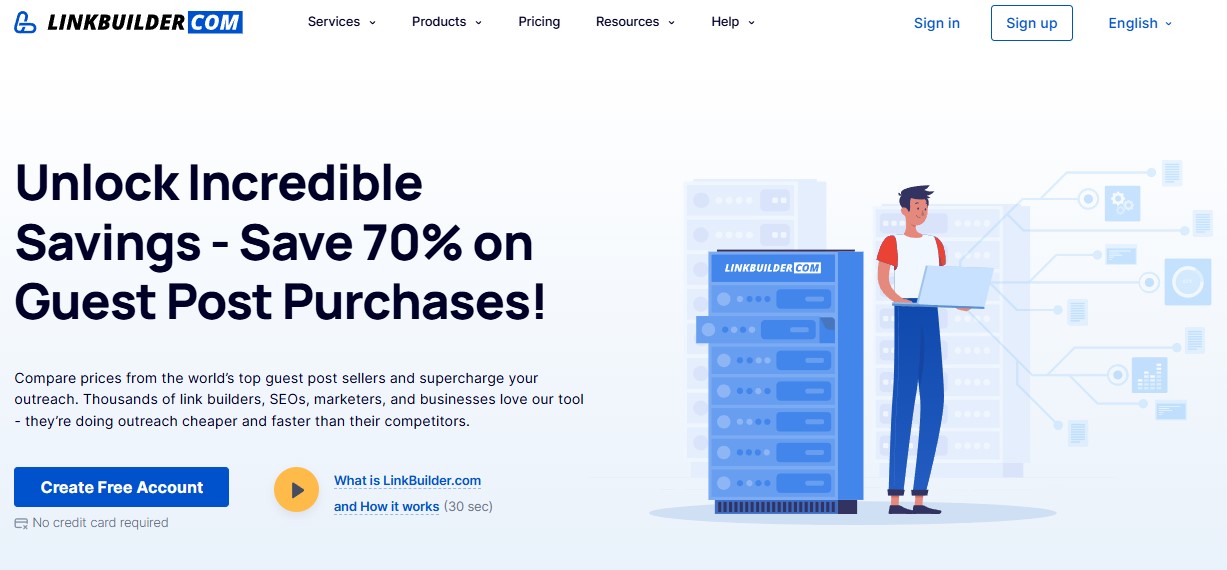
As one of the industry's leading link-building platforms, LinkBuilder.com offers a comprehensive suite of tools and services aimed at enhancing your digital presence. If your brand is already being mentioned across the web without active backlinks, we help you turn those passive references into high-quality links that drive real search engine results.
One of the most significant advantages of using LinkBuilder.com is access to an extensive database of resources where you can discover potentially valuable webpages for backlink placements. The platform serves as a backlink marketplace, enabling you to select the most suitable publishing platforms for acquiring high-quality links.
LinkBuilder.com offers powerful filtering tools that enable you to search for websites based on various parameters, including topic, language, region, and other key SEO metrics. It allows you to efficiently identify mentions of your brand across relevant sources, even if they don't currently include clickable links. With advanced filtering settings, you can pinpoint the most promising websites for outreach and future collaboration.
A vital step in the process is converting unlinked brand mentions into valuable backlinks. You can use the Guest Post Selection Tool and the High-Quality Free Backlink Sites List, both accessible in your personal dashboard, to locate publication platforms that already mention your brand.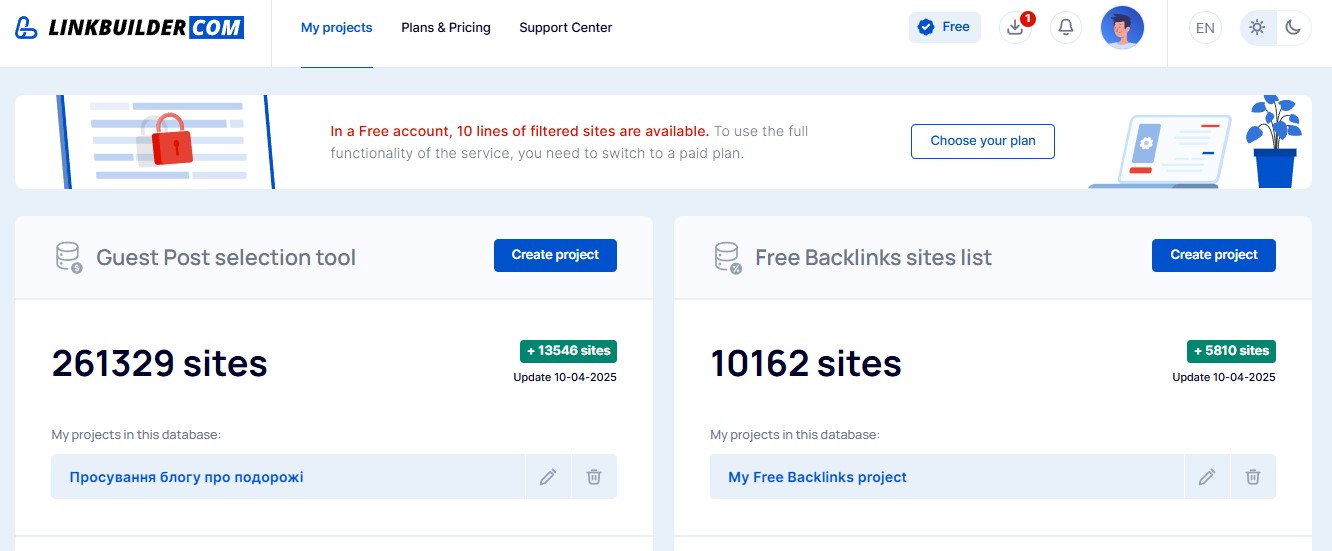
These tools not only help you find placement opportunities but also enable you to compare prices and identify the best offers from different link-building service providers. Once you've selected the right websites, you can contact site owners directly to request link insertion or outsource the process to LinkBuilder.com's expert team, saving you time and ensuring a professional result.
Find unlinked mentions of your brand and turn them into high-quality backlinks with LinkBuilder.com!
Enhance your reputation and improve your website's rankings – get started today!
